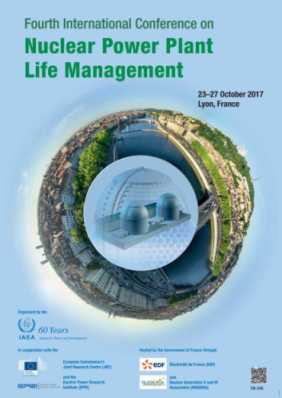Speaker
Dr
Khaled Atya Ahmed Abdallah
(Nuclear Power Plants Authority (NPPA))
Description
The safety and reliability of nuclear power plants can be ensured by appropriate inspection and maintenance. The inspection and maintenance of NPP components should be achieved continuously to keep safe and reliable operation of nuclear power plants. Among NPP systems and components, the healthy and soundness of reactor pressure vessel is the most important. To keep reactor pressure vessel in good condition, a regular inspection during refueling outage is preferable.
Bottom mount instrumentation (BMI) nozzles in bottom head of the nuclear reactor pressure vessel are one of the pressure boundaries in reactor coolant system for inspection of weld cracking, also, the BMI nozzle welds form part of the primary pressure boundary and the weld filler material is of alloy 600 which is known to be susceptible to primary water stress corrosion cracking (PWSCC) which is one of important metallurgical problems facing the nuclear industry. PWSCC refers to a phenomenon in that crack forms due to tensile stress and chemical corrosion in primary coolant loop of PWR system. It is found in weld positions of reactor pressure vessel (RPV), Steam Generator, Pressurizer, and Reactor Coolant Pump. Cracks appear under the presence of three factors: stress, material and water chemistry, most PWSCCs are found within the area of welding between different materials and different component parts connected together.
In April 2003, two of South Texas Project 1 reactor BMI nozzles were found to be leaking, furthermore, the surprising discovery of boron from two nozzles were by visual inspection of the outside of reactor vessel bottom-mounted instrument penetrations during a routine refueling outage. A small powdery substance about 153 mg was found on the outside of two instrument guide penetration nozzles on the BMI nozzle penetration outer surface. On October 6, 2013, BMI nozzle number 3 at Palo Verde Unit 3 (PVNGS-3) exhibited small white de-posits around the annulus, these were later determined to be boric acid. There are 61 bottom head penetrations (outside diameter of 3 inches and inside diameter of 0.75 inches) in the PVNGS-3 reactor pressure vessel. Nozzle attachment to the RV lower head is by J-groove weld to the inside penetration of the nozzle and the weld material is of Alloy 600 material.
Above two cases clearly show the necessity of routine inspection of RV lower head penetration during refueling outage. Nondestructive inspection is generally performed to detect fine cracks or defects that may develop during operation. Defects usually occur at weld regions; hence most non-destructive inspection is to scan and check any defects or crack in the weld region. BMI nozzles at the bottom head of a nuclear reactor vessel (RV) are one of such area for inspection, but BMI nozzles have not been inspected during regular refuel outage due to the relative small size of BMI nozzle and limited impact of the consequences of BMI leak. However, there is growing concern since there have been leaks at nuclear power plants (NPPs) as well as recent operating experience.
The APR1400 RPV is fabricated in accordance with the ASME code section III rules. The RPV is a vertical cylindrical vessel with a removable hemispherical upper closure head, and a hemispherical lower head welded to the vessel shell section. The internal surfaces of RPV that are in contact with the reactor coolant water are cladded with austenitic stainless steel to avoid corrosion. The bottom head is constructed of a single hemispherical forging. The three shell sections, the vessel flange forging, and the bottom head forging are joined together by welding, along with four direct vessel injection (DVI) nozzle forgings, four inlet nozzle forgings, two outlet nozzle forgings, and sixty-one (61) in-core instrument nozzles (ICI) to form a complete vessel assembly. The RPV internals support and orient the control element assemblies, fuel assemblies, and ICI, and guide the reactor coolant through the reactor core and to hot-leg pipe.
The reactor vessel is inspected for any indication of leak or structural damage from the outside of reactor vessel during a refueling outage, however the vessel welds region inspection is done on a 10-year regular periodic inspection. Because there has been leak through BMI nozzles, it is imperative to inspect in a shorter interval, such as inspection during every refueling outage. In order to make such frequent inspection feasible, a special device is necessary to do the job conveniently. For this objective, BMI Inspection Device was conceptualized.
Since the BMI nozzle is submerged in water, the BMI inspection need to be done in submerged environment. Also, the reactor vessel inside environment is highly radioactive, a remote inspection operation concept is adapted to protect operator from radiation. Equipment to protect operator to work under-water would require much more complicated equipment and operation also would require much more complicated procedure to protect operators. Hence, remote operation is more economical option in this case.
In this study, a system that is conveniently used for nondestructive inspection of BMI nozzles during regular refueling outage without removing all the reactor internals. The system can carry and manipulate a special ultrasonic (UT) probe to insert in the BMI nozzle to scan and detect cracks within the weld region of the inner surface of the BMI nozzle. A 3D model of the inspection system was also developed along with the RV and internals which permits a virtual 3D simulation to check the design concept and usability of the system. Moreover, this approach allows for a virtual walk through to verify the proposed BMI nozzle inspection system. The proposed BMI nozzle inspection system will contribute to finding an early detection of weld defects and lead to prevention of leakage at the BMI nozzle and weld.
| Country or International Organization | Egypt |
|---|
Author
Dr
Khaled Atya Ahmed Abdallah
(Nuclear Power Plants Authority (NPPA))

